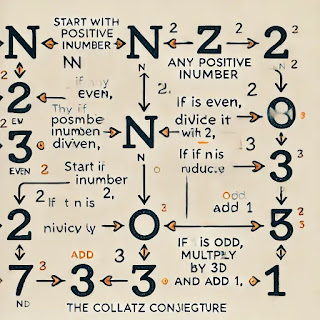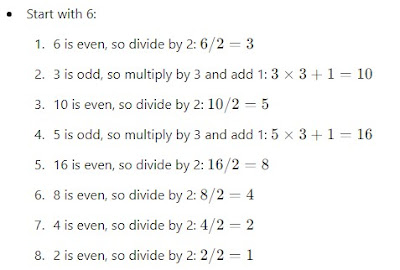The Collatz Conjecture, proposed by mathematician Lothar Collatz in 1937, is a seemingly simple problem that remains unsolved.
1. The Collatz Sequence
Repeat this process with each resulting number. The
conjecture states that no matter which positive integer you start with, you
will always eventually reach 1. Here’s a quick example:
No matter the starting number, this sequence should eventually reach the number 1 according to the conjecture.
2. Mathematical Exploration
Despite its simple rules, the Collatz Conjecture has stumped
mathematicians for decades. The problem is not proving that it works for a
specific set of numbers, but proving it universally for all positive integers.
Extensive computational checks have verified the conjecture for numbers up to
very large values, but a general proof remains elusive.
The difficulty lies in the unpredictable behavior of the
sequence. For some numbers, the sequence quickly reaches 1, while for others,
it takes many steps, often fluctuating wildly before settling down. This
irregularity makes it hard to find a universal mathematical pattern or rule
that applies to all integers.
To understand the complexity, consider how the operations
interact: division by 2 consistently reduces the number, but multiplying by 3
and adding 1 can significantly increase it. This interaction creates a dynamic
system where predicting the long-term behavior of the sequence from any
starting number is extremely challenging. Mathematicians have explored various
approaches, such as examining the sequence in modular arithmetic or looking for
potential invariants, but these efforts have yet to yield a definitive proof.
Furthermore, the Collatz Conjecture touches upon various
fields of mathematics, including number theory, dynamical systems, and even
chaos theory. Each field offers tools and perspectives that could potentially
unlock the mystery, yet the conjecture remains stubbornly resistant to a
general proof. This ongoing challenge underscores the depth and complexity that
can arise from even the simplest mathematical rules.
3. Computational Efforts
Computers have been used extensively to test the Collatz
Conjecture. Programs run through vast numbers, calculating the sequences and
checking if they eventually reach 1. So far, every number tested has conformed
to the conjecture, yet no algorithm or proof has been found to verify it
universally.
Efforts to find a counterexample (a number that does not
reach 1) have been unsuccessful. These computational checks add weight to the
conjecture's validity but do not constitute a proof. A proof must demonstrate
why the conjecture holds true for all possible integers, not just the ones
tested.
Advanced algorithms and powerful computers have enabled
mathematicians to test the Collatz Conjecture up to extremely high numbers,
sometimes in the range of 10^20 or more. These extensive tests have not only
confirmed the conjecture for all numbers within this range but also provided
valuable data on the behavior of the sequences. For example, researchers have
observed patterns in how quickly different starting numbers reach 1 and how the
sequences' lengths and peak values vary.
Despite these computational successes, the fundamental
question remains unanswered: why does every sequence eventually reach 1? Some
researchers have used statistical and probabilistic methods to analyze the
conjecture, seeking to understand the average behavior of the sequences. Others
have explored connections to other unsolved problems in mathematics, hoping
that insights from related fields might shed light on the Collatz Conjecture.
However, the lack of a comprehensive theoretical framework means that these
efforts, while informative, have yet to provide a conclusive answer.
4. Implications and Importance
The Collatz Conjecture is more than just a curious puzzle;
it has implications for understanding complex systems and iterative processes.
It highlights how simple rules can lead to unpredictable and complex behaviors.
Solving it could potentially unlock new methods for tackling other unsolved
problems in mathematics and computer science.
Moreover, the conjecture has inspired numerous mathematical
papers and research efforts, exploring its connections to other areas of
mathematics, such as number theory and dynamical systems. It serves as a prime
example of how a straightforward problem can reveal deep and complex underlying
structures.
One significant implication of the Collatz Conjecture is its
relevance to the study of algorithms and computational complexity.
Understanding why the sequence always reaches 1 could provide insights into the
behavior of algorithms that involve iterative processes and recursive
functions. This could have practical applications in computer science,
particularly in areas like cryptography, data compression, and optimization,
where iterative algorithms are commonly used.
The conjecture also touches on the concept of universality
in mathematics. If a general proof is found, it could demonstrate a universal
property of numbers that transcends specific cases and patterns. This
universality would reinforce the interconnectedness of mathematical principles
and could lead to new discoveries in seemingly unrelated areas of mathematics.
Additionally, the Collatz Conjecture serves as a valuable
teaching tool, illustrating the beauty and challenge of mathematical research.
It encourages critical thinking, problem-solving, and the exploration of
mathematical ideas from multiple perspectives. For students and researchers
alike, the conjecture embodies the spirit of mathematical inquiry: a simple
question with profound implications, inspiring curiosity and perseverance.
The Collatz Conjecture remains one of mathematics' most fascinating unsolved problems. Its simplicity is deceptive, masking a depth of complexity that has challenged some of the brightest minds for over 80 years. While extensive computational testing supports the conjecture, a general proof continues to elude mathematicians. Solving this problem would not only be a significant achievement in mathematics but also enhance our understanding of complex systems governed by simple rules. Until then, the Collatz Conjecture stands as a reminder of the mysteries that still await us in the realm of numbers.










0 Comments:
Post a Comment